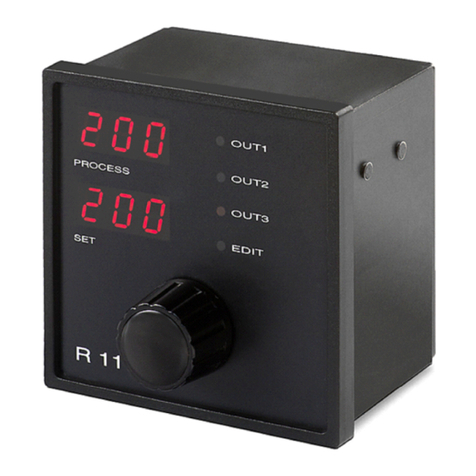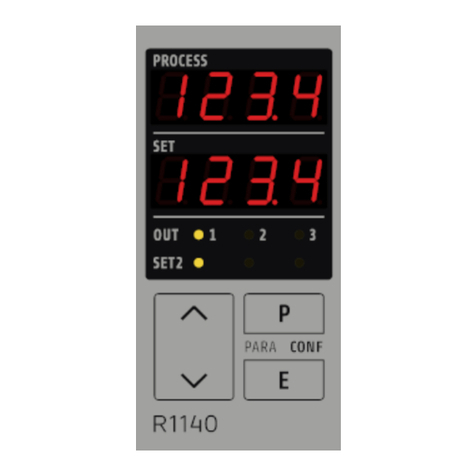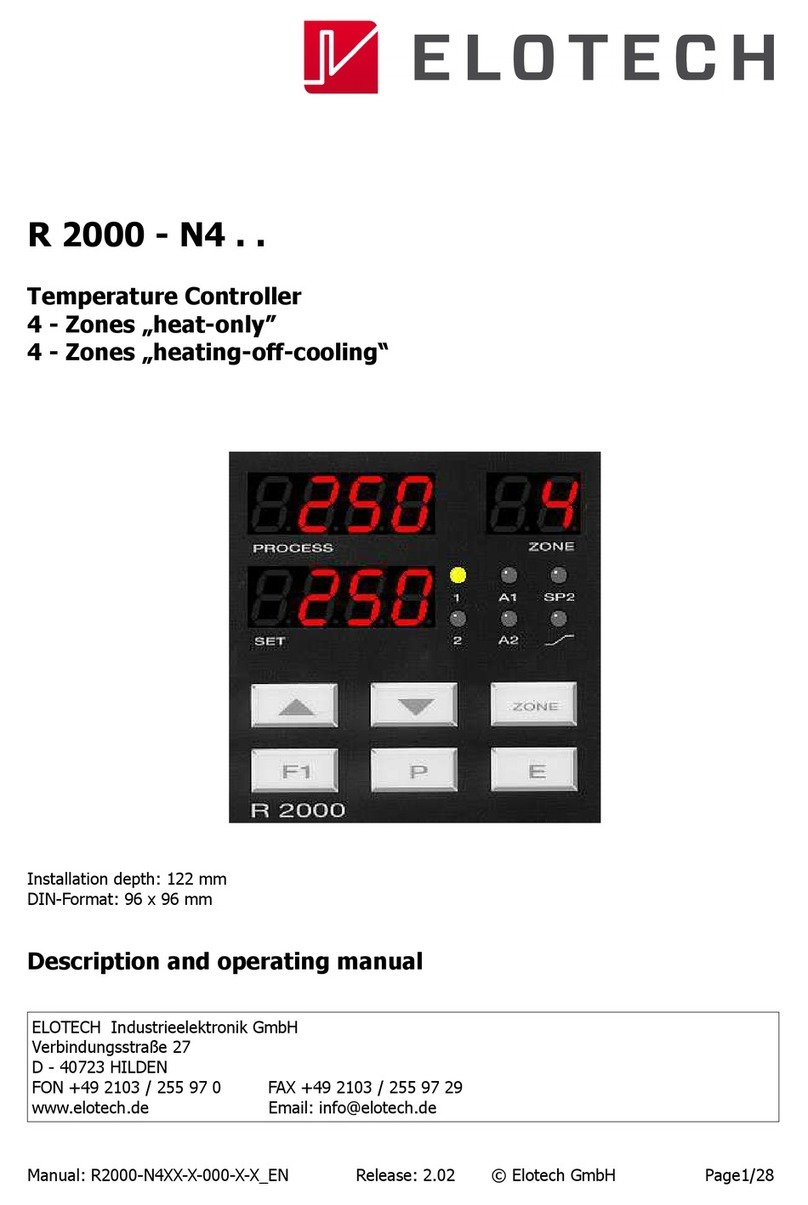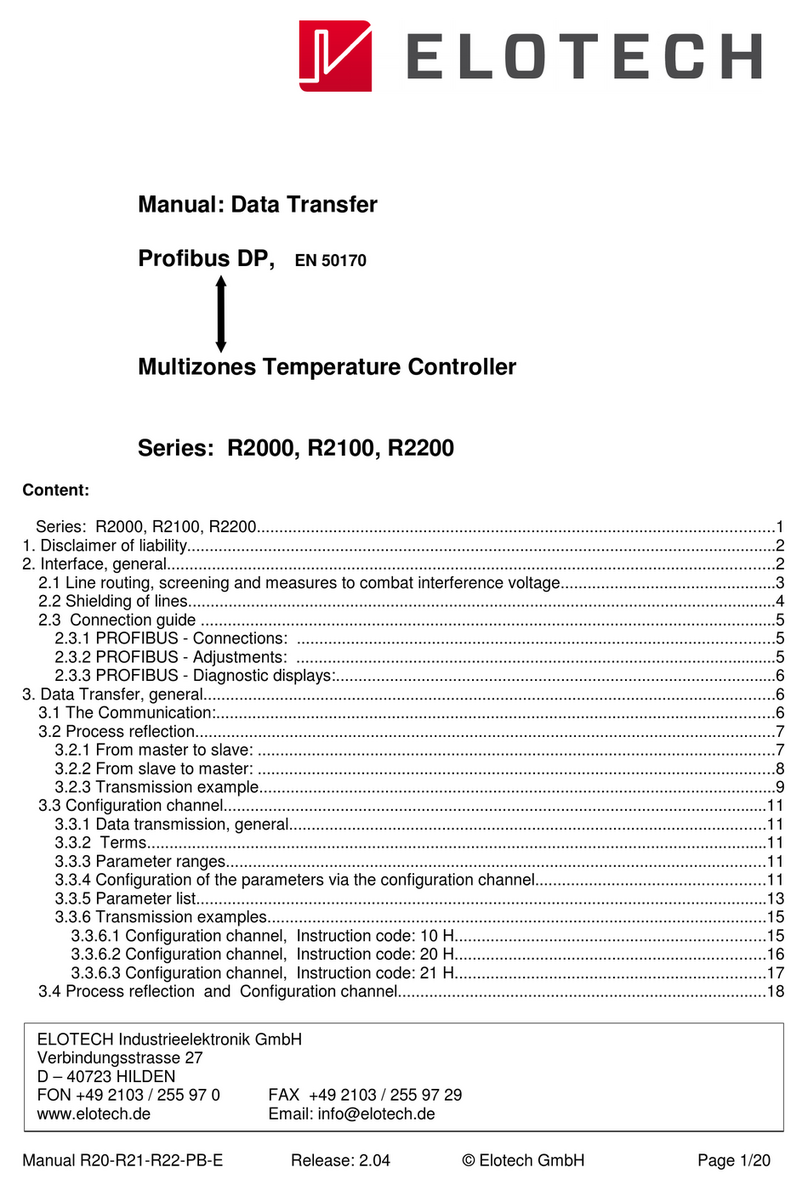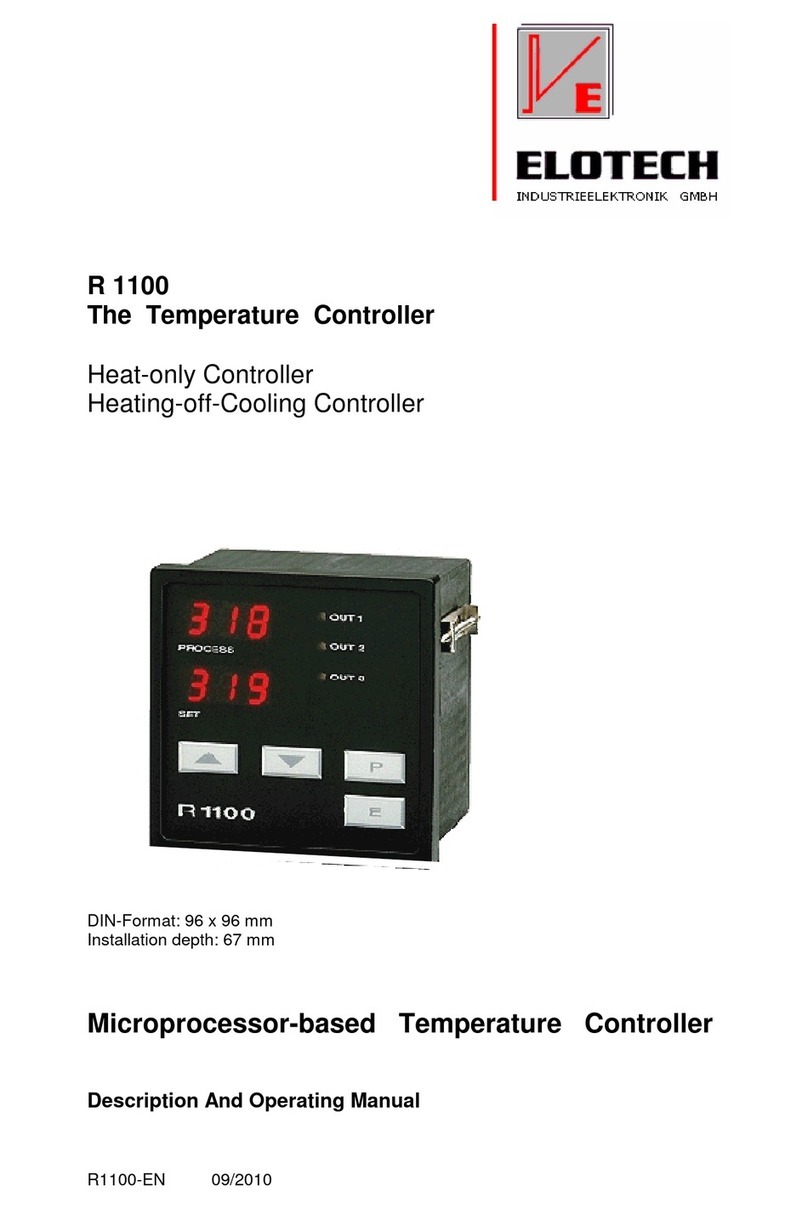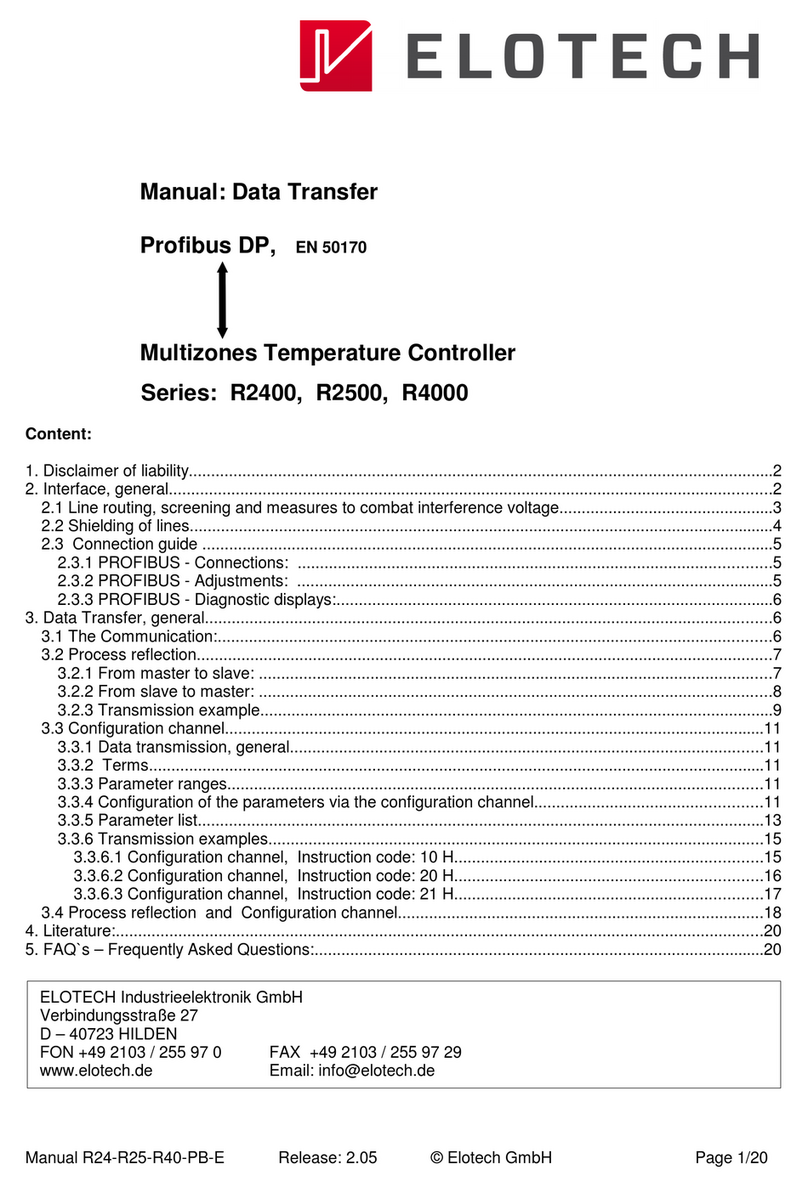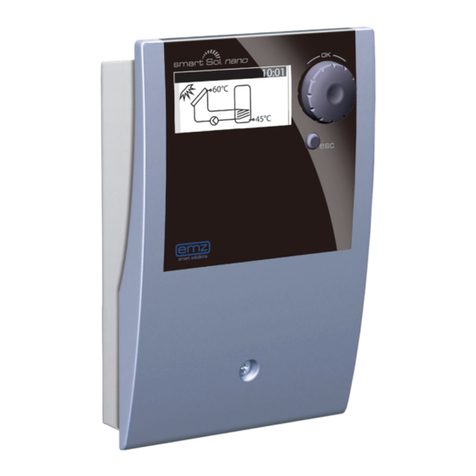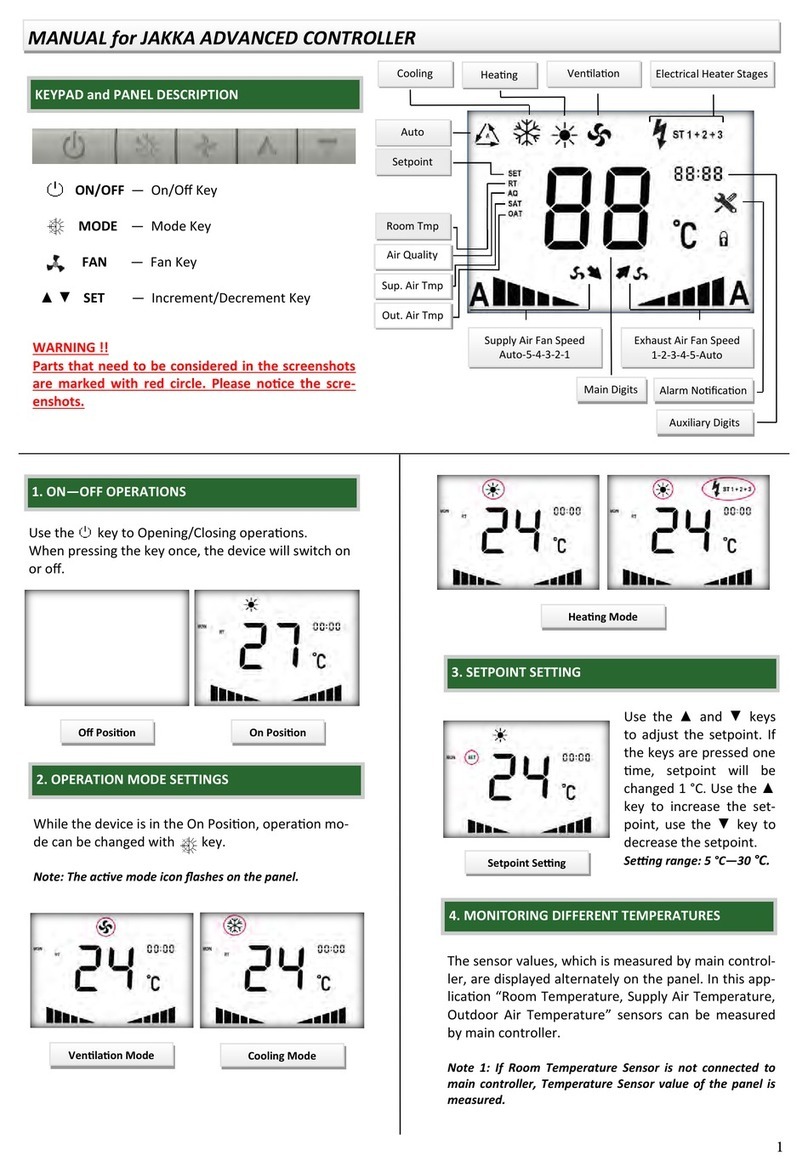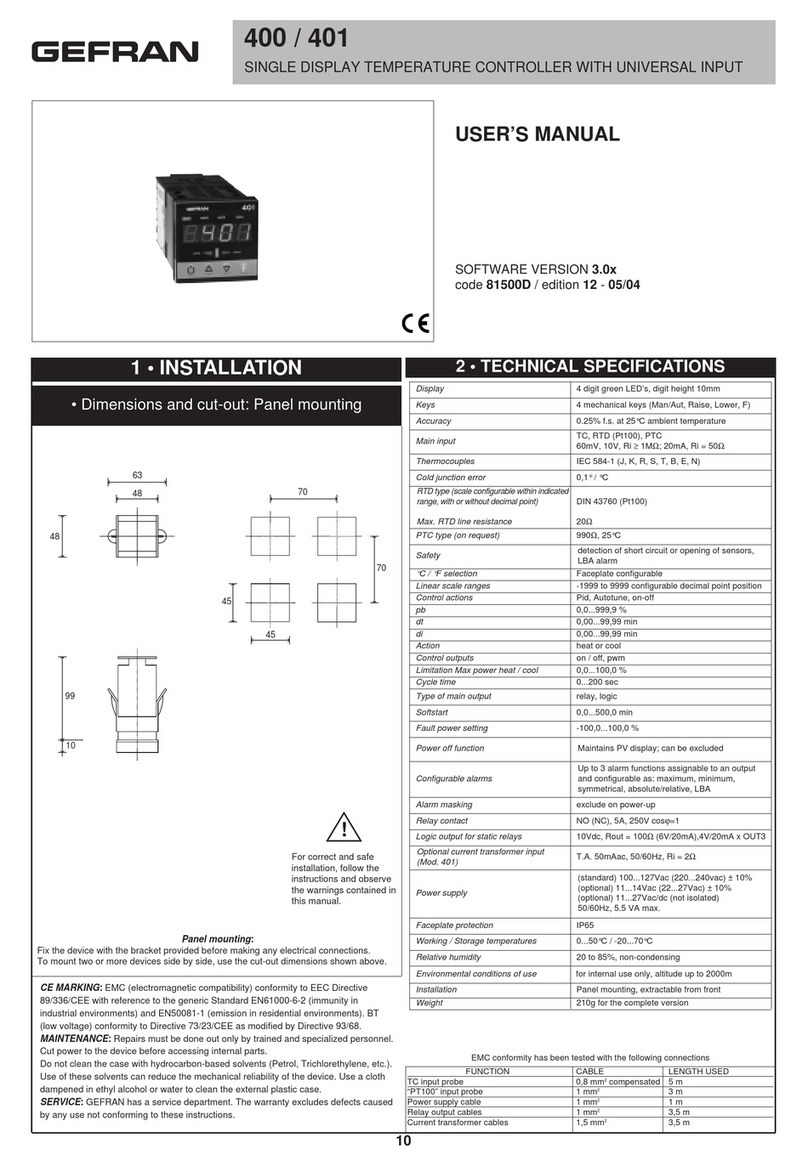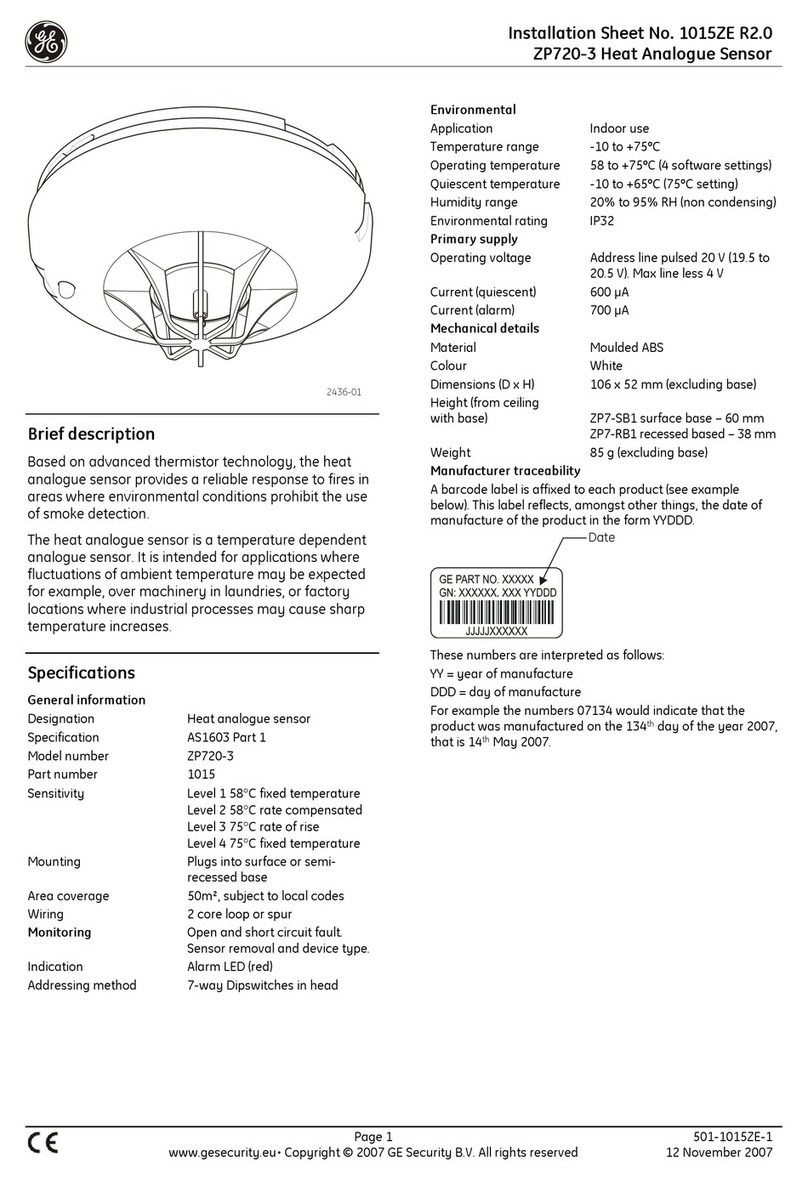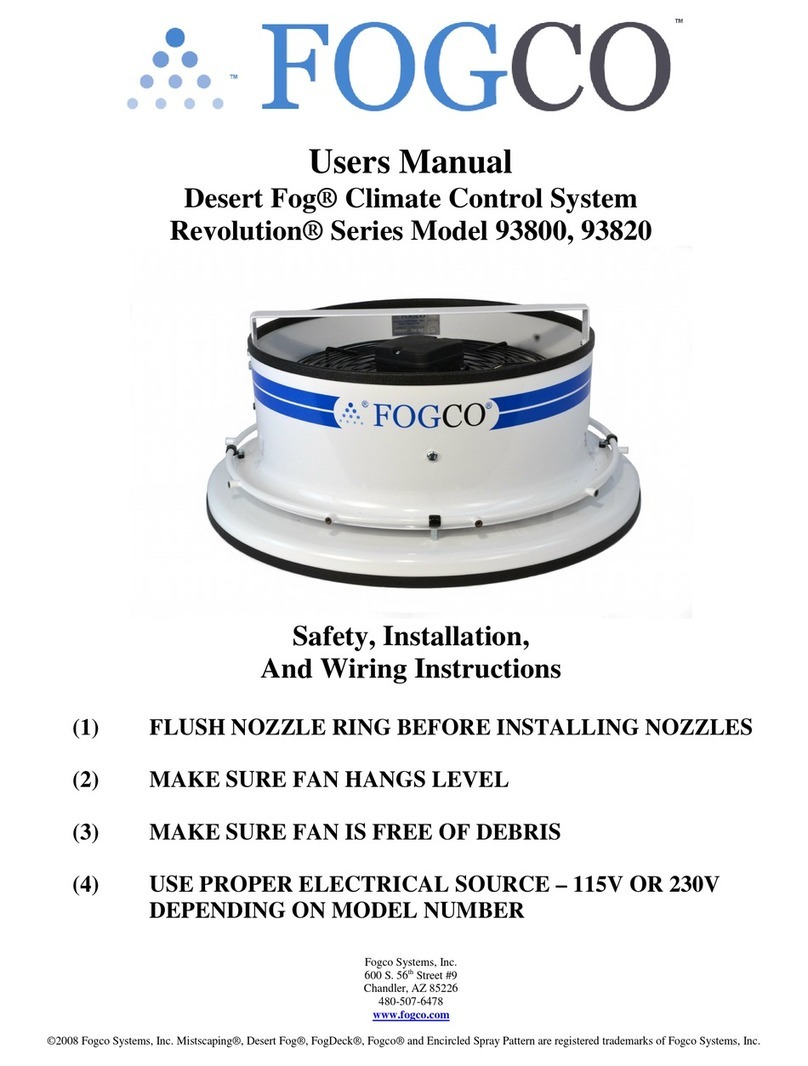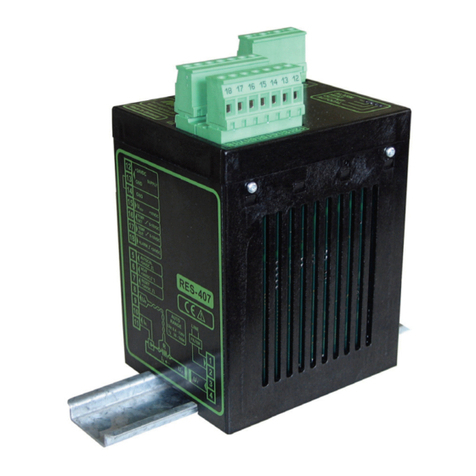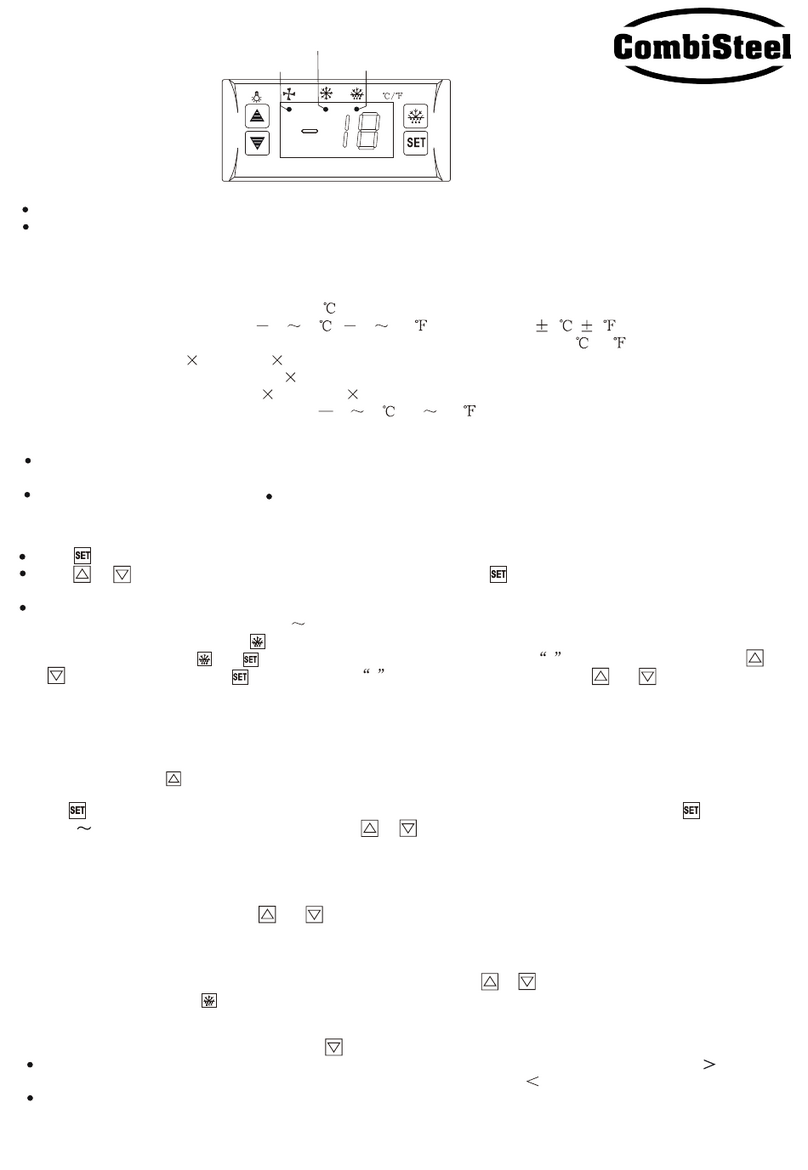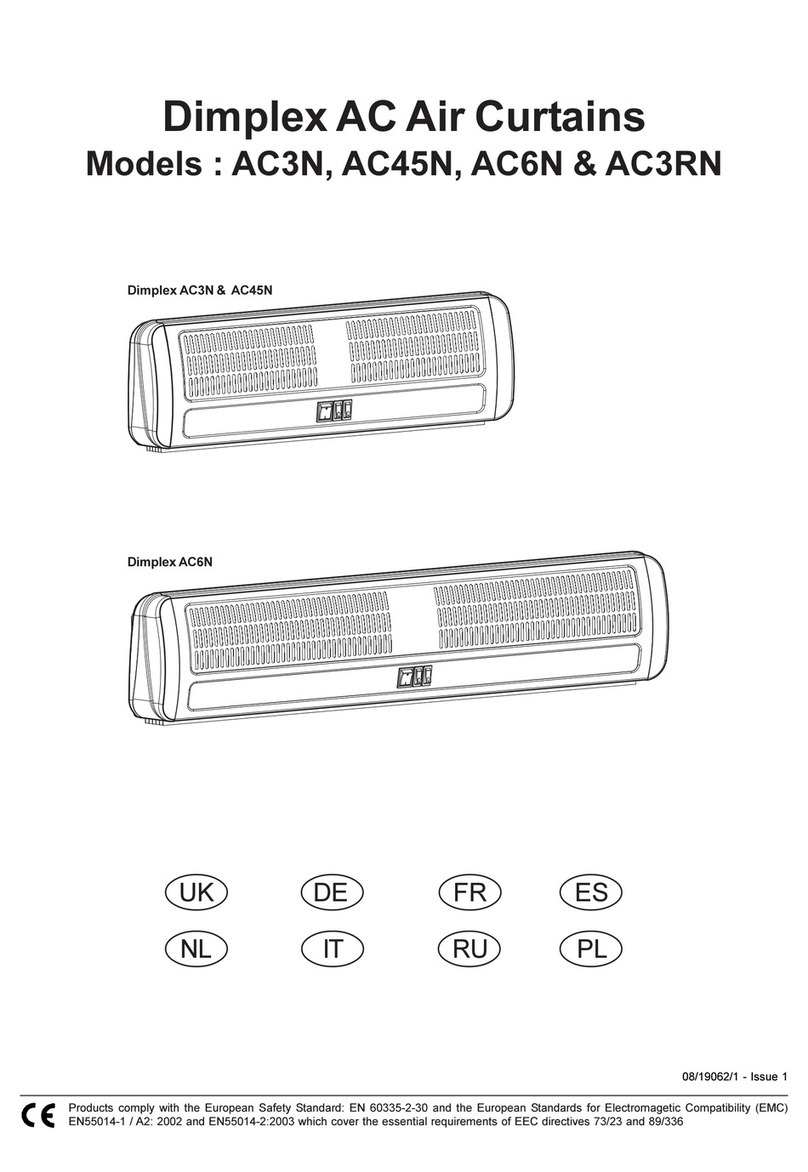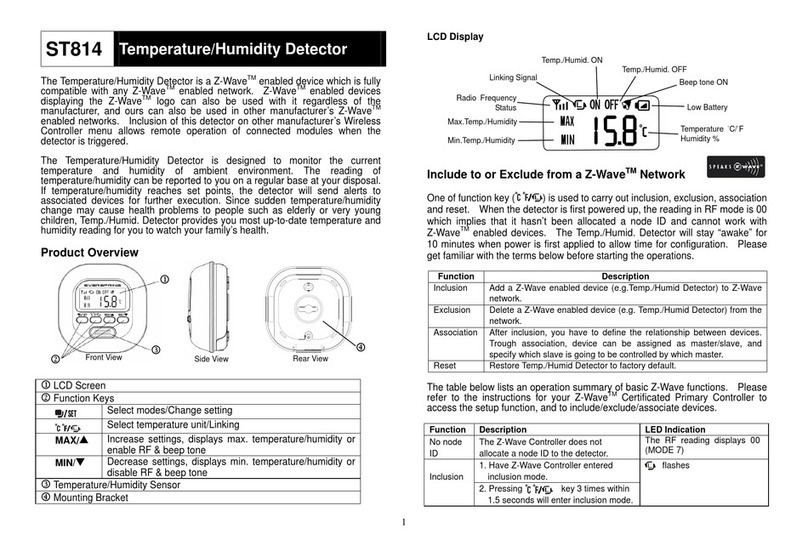Elotech R 1140 User manual

Manual R1140-PB-E Release: 2.03 © Elotech GmbH Page 1/16
Manual:
Data Transfer
Profibus DP,
EN 50170
Temperature Controller
Type: R1140
Content:
1.
Disclaimer of liability...........................................................................................................................2
2.
Interface, general................................................................................................................................2
2.1
Line routing, screening and measures to combat interference voltage ..........................................3
2.2
Shielding of lines.............................................................................................................................4
2.3
Connection guide ............................................................................................................................5
3.
Data transfer, general.........................................................................................................................6
3.1
Process reflection............................................................................................................................6
3.1.1
From master to slave:..............................................................................................................6
3.1.2
From slave to master:..............................................................................................................7
3.1.3
Transmission example.............................................................................................................8
3.2
Configuration channel .....................................................................................................................9
3.2.1
Data transmission, general......................................................................................................9
3.2.2
Terms.......................................................................................................................................9
3.2.3
Parameter values.....................................................................................................................9
3.2.4
Configurating of the parameters via the configuration channel. ..............................................9
3.2.5
Parameter list.........................................................................................................................11
3.2.6
Transmission examples.........................................................................................................13
3.3
Process reflection and Configuration channel.............................................................................16
ELOTECH Industrieelektronik GmbH
Verbindungsstrasse 27
D – 40723 HILDEN
FON +49 2103 / 255 97 0 FAX +49 2103 / 255 97 29

Manual R1140-PB-E Release: 2.03 © Elotech GmbH Page 2/16
1. Disclaimer of liability
We have checked the contents of the document for conformity with the hardware and software
described. Nevertheless, we are unable to preclude the possibility of deviations so that we are
unable to assume warranty for full compliance. The information given in the publication is,
however, reviewed regularly. Necessary amendments are incorporated in the following editions.
We would be pleased to receive any improvement proposals which you may have.
This document may not be passed on nor duplicated, nor may its contents be used or disclosed
unless expressly permitted.
Note: Only in PROFIBUS-technologie trained personnel following the safety regulations
may do the PROFIBUS - connections.
It is essential, that one has well experience in installing a profibus device.
2. Interface, general
The ELOTECH – temperature controller is equipped with a PROFIBUS DP interface.
The temperature controller actuates as a slave.
MASTER Profibus - DP Temperature
Controller
The PROFIBUS -interface allows the slave to be monitored and controlled by a PROFIBUS master.
The data transfer between the slave and master takes place with the aid of the PROFIBUS-DP-protocol
acc. to EN 50170.
The communication is always controlled by the PROFIBUS-DP master.
The adress of the slave has to be programmed in the configuration level of the slave.
If there are transmission or other errors detected by the slave, it doesn`t accept this datas.
The old parameter values are still valid.
Slave adjustments:
Unit adress ( Adr ): The adress of the slave 1...255 has to be adjusted into the
configuration level. See parameter „Adr“.
Baudrate bAUd ): 9,6 kBaud ... 12 MBaud (with automatically detected)
Please take attention to the manual of the specific temperature controller.
See: FAQ`s
GDS - data file:
Will be delivered with each slave on disk.

Manual R1140-PB-E Release: 2.03 © Elotech GmbH Page 3/16
2.1 Line routing, screening and measures to combat interference voltage
This chapter deals with line routing in the case of bus, signal and power supply lines, with the
aim of ensuring an EMC-compliant design of your system.
General information on line routing
- Inside and outside of cabinets
In order to achieve EMC-compliant routing of the lines, it is advisable to split the lines into the
following line groups and to lay these groups separately.
Group A: •shielded bus and data lines (e.g. for PROFIBUS-DP, RS232C and printers etc.)
•shielded analogue lines
•unshielded lines for DC voltages ≥ 60 V
•unshielded lines for AC voltage ≥ 25 V
•coaxial lines for monitors
Group B: •unshielded lines for DC voltages ≥ 60 V and ≥ 400 V
•unshielded lines for AC voltage ≥ 24 V and ≥ 400 V
Group C: •unshielded lines for DC voltages > 400 V
The table below allows you to read off the conditions for laying the line groups on the basis of the
combination of the individual groups.
Line laying instructions as a function of the combination of line groups:
Group A Group B Group C
Group A 1 2 3
Group B 2 1 3
Group C 3 3 1
1) Lines may be laid in common bunches or cable ducts.
2) Lines must be laid in separate bunches or cable ducts (without minimum clearance).
3) Lines must be laid in separate bunches or cable ducts inside cabinets but on separate cable
racks with at least 10 cm clearance outside of cabinets but inside buildings .

Manual R1140-PB-E Release: 2.03 © Elotech GmbH Page 4/16
2.2 Shielding of lines
Shielding is intended to weaken (attenuate) magnetic, electrical or electromagnetic interference
fields.
Interference currents on cable shields are discharged to earth via the shielding bus which is con-nected
conductively to the chassis or housing. A low-impedance connection to the PE wire is
particularly important in order to prevent these interference currents themselves becoming an
interference source.
Wherever possible, use only lines with braided shield. The coverage density of the shield should
exceed 80 %. Avoid lines with foil shield since the foil can be damaged very easily as the result
of tensile and compressive stress on attachment. The consequence is a reduction in the shiel-ding
effect.
In general, you should always connect the shields of cables at both ends. The only way of achie-ving
good interference suppression in the higher frequency band is by connecting the shields at
both ends.
The shield may also be connected at one end only in exceptional cases. However, this then
achieves only an attenuation of the lower frequencies. Connecting the shield at one end may be
more favourable if
• it is not possible to lay an equipotential bonding line
• analogue signals (a few mV resp. mA) are to be transmitted
• foil shields (static shields) are used.
In the case of data lines for serial couplings, always use metallic or metallised plugs and connectors.
Attach the shield of the data line to the plug or connector housing. Do not connect the shield
on the connector of the slave (controller).
If there are potential differences between the earthing points, a compensating current may flow
via the shield connected at both ends. In this case, you should lay an additional equipotential
bonding line.
Please note the following points when shielding:
• Use metal cable clips to secure the shield braiding. The clips must surround the shield over a
large area and must have good contact.
• Downstream of the entry point of the line into the cabinet, connect the shield to a shielding bus.
Continue the shield as far as the module, but do not connect it again at this point!

Manual R1140-PB-E Release: 2.03 © Elotech GmbH Page 5/16
2.3 Connection guide
Note: Only in PROFIBUS-technologie trained personnel following the safety regulations
may do the PROFIBUS - connections.
It is essential, that one has well experience in installing a profibus device.
You will require the following components to connect the slave:
• Connector for Profibus connection to the slave
• PROFIBUS cable (this cable is generally already installed on site!)
• Diskette with type resp. GSD file
• Project planning tool for the PROFIBUS-Master
It is essential, that you perform the following during connecting in order to ensure that
the slave operates correctly:
PROFIBUS-Connections:
Connect the slave with the PROFIBUS. Take care to the terminals.
See: connection diagram of the specific controller type.
The terminals VP and GND have to be used to connect the terminating-resistors.
There is no further load allowed.
The terminating resistors have to be connected on the first and the last device of the Profibus-
bus.
Terminating-Resistors (Tol. +/-2%): VP +5V
390 R
RxTxP
220 R
RxTxN
390 R
GND
CNT
PROFIBUS – Adjustments:
Adjust the following parameters (slave):
Series R1140:
Parameter „Adress“: Adr: Adjustment of the Profibus-Adress
Parameter „Baudrate“: baud No adjustment possible.
The baudrate will detected and monitored automatically.
Display: „ndEt“ = no baudrate detected.
PROFIBUS - Diagnostic displays:
The diagnostic display works with the help of the decimal-point within parameter „Adr – Adress“.
The slaves of the series R11400 have to be set to „remote operation“ with the parameter „rEno“.
This makes sure, that the parameter values can be written via the profibus.
Dec.point, permanent on: The slave is in the data-exchange-modus.
The communication is ok.
The data-exchange with the master takes place.
Dec.point, flashing: The bus is detected. The slave is waiting until the master has
programmed the slave. This happens automatically.
Dec.point off: The slave is not correct connected to the bus.
E.g.:- Maybe there is a wiring error. - The master is not active.

Manual R1140-PB-E Release: 2.03 © Elotech GmbH Page 6/16
3. Data transfer, general
The Communication:
The master sends it´s data to the slave.
After this the slave sends an answer to the PROFIBUS DP - master.
This takes place cyclic and will be controlled by the master.
The configuration of the slave takes place with the help of the GSD-file.
The following moduls are available for the slave:
1. Process reflection: Module: „1 – channel process data“
2. Configuration channel: Module: „parameter channel“
3. Process reflection and Configuration channel:Module: „1 – channel process + parameter“
3.1 Process reflection
Parameter transfer according to the process reflection modul:
3.1.1 From master to slave:
Transfer of Setpoint 1 and Status word 1
Byte 1 Byte 2 Byte 3
Setpoint 1
High Byte
Setpoint 1
Low Byte
Control byte
WARNING: Every change of the setpoint is stored in the internal
nonvolatile memory. It permits max. 1.000.000 write
cycles!
Setpoint / process value: The parameter value consists out of 2 data bytes within the process
reflection.
Setpoint and actual process values will be transmitted always with a
decimal digit, although the measuring range has no decimal digit.
Example: °C Dec. Hex. High-Byte Low-Byte
Measuring range with dec. point: act. value 23,0 230 00E6 00 E6
Measuring range with dec. point: setpoint 170,0 1700 06A4 06 A4
Measuring range without dec. point: act. value 23 230 00E6 00 E6
Measuring range without dec. point: setpoint 170 1700 06A4 06 A4
Control byte: The parameter consist out of one data byte:
Bit 0: controller / slave 0 = on, 1 = off
Bit 1: self tuning 0 = off, 1 = on
Changing this bit from „0“ to „1“ will force the controller to do one selftuning action.
Set this bit to „0“, before starting a new selftuning action.
Bit 2: 0
Bit 3: actual setpoint 0 = setpoint SP1, 1 = setpoint SP2
Bit 4: 1 = delete warning „selftuning error“ into the status byte
Bit 5: 0
Bit 6: 0
Bit 7: 1 = delete warning „system error“ into the status byte

Manual R1140-PB-E Release: 2.03 © Elotech GmbH Page 7/16
3.1.2 From slave to master:
Transfer of the process data
Byte 1 Byte 2 Byte 3 Byte 4 Byte 5 Byte 6
Status
Setpoint
High Byte
Status
Setpoint
Low Byte
Actual
Process
temperature
High Byte
Actual
Process
temperature
Low Byte
Status byte
Alarm status
Status setpoint: Indicates, if a range error has been detected, when writing the setpoint:
Bit 0: 0 = setpoint value ok.
1 = setpoint value not ok. (out of range ?)
Bit 1–15: no function
Status byte: The parameter consist out of one data byte:
Bit 0: controller / slave 0 = on, 1 = off
Bit 1: self tuning 0 = off, 1 = on
Bit 2: remote action 0 = on, 1 = off, operation via keyboard
Bit 3: actual setpoint 0 = setpoint SP1, 1 = setpoint SP2
Bit 4: 1 = selftuning error
Bit 5: 1 = setpoint ramp function active
Bit 6: 1 = sensor error
Bit 7: 1 = system error
Alarm status: Bit 0 1 = alarm 1 active
Bit 1 1 = alarm 2 active
Bit 2–7:no function

Manual R1140-PB-E Release: 2.03 © Elotech GmbH Page 8/16
3.1.3 Transmission example
From master to slave: transfer of setpoint 1 and control byte
Byte 1 + 2: The setpoint 50,0°C should be send to the slave.
Setpoint: 500 decimal = 0x01F4 hexadecimal as a 16 bit integer-value
Byte 3: The slave should be switched „on“ (Bit 0 = 0).
Byte 1 Byte 2 Byte 3
Setpoint
High Byte
0x01
Setpoint
Low Byte
0xF4
Control byte
0x00
Answer from slave to master:
Transmission of the process reflection
The slave sends the following parameter-values:
Byte 1 + 2: status instruction setpoint transmission: the last instruction was ok.
Byte 3 + 4: act.process temp. value: 55,0°C 550dec. = 0x226hex. as a 16 bit integer-value
Byte 5: Controller status: controller = on
Byte 6: Alarm status: alarm = no alarm
Byte 1 Byte 2 Byte 3 Byte 4 Byte 5 Byte 6
Status
Setpoint
High Byte
0x00
Status
Setpoint
Low Byte
0x00
Actual
Process
temperature
High Byte
0x02
Actual
Process
temperature
Low Byte
0x26
Status byte
0x00
Alarm status
0x00

Manual R1140-PB-E Release: 2.03 © Elotech GmbH Page 9/16
3.2 Configuration channel
With the help of the configuration channel each parameter can be adressed individually.
The sequence of the desciped bytes is valid for „question“ and „answer“.
3.2.1 Data transmission, general
The PROFIBUS – master is allowed to monitore and controll all parameters of the slave.
The transfer of instructions and parameter values takes place with the aid defined data blocks.
3.2.2 Terms
Instruction-code [BC]: "tells" the device/slave, what to do (1 Byte)
Parameter-code [PC]: designates each individual parameter of the device (1 Byte)
Parameter-value [PW]: shows the value of a parameter (3 Byte)
3.2.3 Parameter values
Instruction-code [BC]: 0x10, 0x20, 0x21
Parameter-code [PC]: 0x00...0xFF
Parameter-value [PW]: 16 bit integer, mantissa PWH and PWL and exponent PWE base 10
Parameter-value High-Byte [PWH]
Parameter-value Low- Byte [PWL]
Parameter-exponent [PWE]
3.2.4 Configurating of the parameters via the configuration channel.
Byte 1 Byte 2 Byte 3 Byte 4 Byte 5 Byte 6 Byte 7 Byte 8
Current
number
0x00 ... 0xFF
Always:
0x01
Instruction
code
BC
0x10, 0x20 od.
0x21
Always:
0x00
Parameter-
code
PC
0x00 ... 0xFF
Parameter-
value
PWH
High-Byte
Parameter-
value
PWL
Low-Byte
Exponent
PWE
0x00 ... 0xFF
Byte 1
Current Number: For every new task the master should preset a current number.
This number will be repeated from the slave with every answer.
So it is possible to find out which instruction and which answer belong together.

Manual R1140-PB-E Release: 2.03 © Elotech GmbH Page 10/16
Byte 2: always 0x01
Byte 3
Instruction code, BC: 0x10 : Read parameter
0x20 : Write parameter
0x21 : Write parameter and store with powerfail protection
Take care: The EAROM or EEPROM of the slave
permits max. 1.000.000 write cycles.
Byte 4: always 0x00
Byte 5
Parameter code, PC: Enquiry:
Adresses the parameter which should be configured.
Answer:
If the read-proceeding to the slave was ok., than, in the answer of the slave,
byte 5 shows the parameter-code PC.
If the write-proceeding to the slave was ok., than, in the answer of the slave,
byte 5 shows the value 00H (acknowledge).
If the communication was not ok., the following error-warnings are shown in
byte 5:
03 H - Procedure error (instruction code not valid)
04 H - Non-compliance with specified range (value to low orto high)
05 H - Byte 2 ≠0
06 H - The adressed parameter is a read-only parameter
07 H - Writing of datas not possible. Slave status is not „remote“.
08 H - Parameter-code not valid
09 H - It is not possible, to execute the instruction
(e.g., the autotuning can´t be started)
FEH - Error during writing into the powerfail storage
FFH - General error
Byte 6, 7 und 8
Parameter value: The parameter value comprises three data bytes:
2 data byte (mantissa), 1 data byte (exponent).
Byte 6: Parameter value PWH
Byte 7: Parameter value PWL
Byte 8: Parameter value PWE
Examples: Dec. Hex. Mantissa Dec. point
Process value (°C): 215 00D7 00D7 00
Setpoint (°C): 230 00E6 00E6 00
Output ratio, cooling (%) -16 FFF0 FFF0 00
Setpoint ramp (°C/min): 2,2 0016 0016 01
The parameter value is calculated as follows: Dec.: 2,2 = 22 + 1 dec.point
Hex.: = 0016 (mantissa)
= 01 (1 dec. point)
Negative mantissa / negative Exponent: Built binary two´s complement.

Manual R1140-PB-E Release: 2.03 © Elotech GmbH Page 11/16
3.2.5 Parameter list
Parameter Mnemonics
Parameter-
Code R1140
Actual process values:
Act. temperature value 0x10 RO
Temperature offset value OFSt 0x18 RW
Sensor configuration SEn 0x1a RW
Linear input; decimal points r. dP 0x1d RW
Linear input; bottom end value r. Lo 0x1e RW
Linear input; top end value r. Hi 0x1f RW
Setpoints:
Act. setpoint SP, act. 0x20 RO
Setpoint 1 SP1 0x21 RW
Setpoint 2 SP2 0x22 RW
Setpoint limitation, low range SP.Lo 0x2b RW
Setpoint limitation, high range SP.Hi 0x2c RW
Setpoint ramp, rising SP ↑0x2f RW
Setpoint range, falling SP ↓0x2d RW
Alarms:
Alarm 3, Configuration Co.A3 0x34 RW
Alarm 2, Configuration Co.A2 0x35 RW
Alarm value 3 AL3 0x38 RW
Alarm value 2 AL2 0x39 RW
Switching behaviour A3 rE.A3 0x3c RW
Switching behaviour A2 rE.A2 0x3d RW
PID parameters „heating“:
Proportional range (P) 1 P 0x40 RW
Rate time (D) 1 d 0x41 RW
Reset time (I) 1 I 0x42 RW
Cycle time 1 CY 0x43 RW
Control sensitivity 1 Sd 0x47 RW
Dead band /
switch-point difference
(only for 3-point-contr.)
Sh 0x46 RW
PID parameters „cooling“:
Proportional range (P) 2 P 0x50 RW
Rate time (D) 2 d 0x51 RW
Reset time (I) 2 I 0x52 RW
Cycle time 2 CY 0x53 RW
Control sensitivity 2 Sd 0x57 RW

Manual R1140-PB-E Release: 2.03 © Elotech GmbH Page 12/16
Parameter
Mnemonics Parameter-
Code R1140
Parameters,
3-point-stepping controller:
Proportional range (P) P 0x40 RW
Motor actuating time tS 0x41 RW
Reset time (I) tn 0x42 RW
Dead band /
switch-point difference Sh 0x46 RW
Control sensitivity Sd 0x47 RW
Output ratio:
Actual output ratio Y 0x60 RO
Manual output ratio HAnd 0x62 RW
Output ratio limit (heating) 1LY 0x64 RW
Output ratio limit (cooling) 2LY 0x69 RW
Softstart output ratio So. Y 0x6a RW
Softstart setpoint So.Sp 0x6b RW
Softstart duration time So.ti 0x6c RW
Softstart function on/off So.St 0x6d RW
Status words:
Controller status / status byte 0x78 RW
Controller configuration:
Control action ConF 0x80 RW
Out1 or Out2 – configuration:
bist. voltage output Out4 0x83 RW
Adjustment lock LOC 0x85 RW
Self tuning OPt 0x88 RW
Manual output configuration
(PID) Hand 0x8b RW
Controller off/on Cont 0x8f RW

Manual R1140-PB-E Release: 2.03 © Elotech GmbH Page 13/16
3.2.6 Transmission examples
3.2.6.1 Configuration channel, Instruction code: 10 H
The slave is asked, to send the parameter „Process value, 10 H“ to the master.
The process value is 225 °C. 225 (Decimal) = 0xE1 (Hex)
Master to slave: Dec. Hex
Current number: 1 0x01
Always: 1 0x01
Send parameter: 16 0x10
Always: 0 0x00
Parameter code (process value): 16 0x10
Parameter value (High-Byte): 0 0x00
Parameter value (Low -Byte): 0 0x00
Exponent: 0 0x00
Transmission to slave: 0x01, 0x01 0x10, 0x00, 0x10, 0x00, 0x00, 0x00
Slave to master: Dec. Hex
Current number of instruction: 1 0x01
Always: 1 0x01
Send parameter: 16 0x10
Always: 0 0x00
Parameter code (process value): 16 *) 0x10
Parameter value (High-Byte): 0 0x00
Parameter value (Low -Byte): 225 0xE1
Exponent: 10° 0 0x00
Transmission to master: 0x01, 0x01 0x10, 0x00, 0x10, 0x00, 0xE1, 0x00
*) Repetition of the parameter code (PC = 16), because the read-process was ok.

Manual R1140-PB-E Release: 2.03 © Elotech GmbH Page 14/16
3.2.6.2 Configuration channel, Instruction code: 20 H
The slave gets the instruction:
"Overtake parameter „prop.-band heating“ (parameter code: 40H, parameter value: 5,0 %)
and store into the RAM".
Master to slave: Dec. Hex
Current number: 2 0x02
Always: 1 0x01
Instruction code: 32 0x20
Always: 0 0x00
Parameter code: 64 0x40
Parameter value (High-Byte): 0 0x00
Parameter value (Low -Byte): 50 0x32
Dec.-point 1 0x01
Transmission to slave: 0x02, 0x01, 0x20, 0x00, 0x40, 0x00, 0x32, 0x01
Slave to master: Dec. Hex
Current number of instruction: 2 0x02
Always: 1 0x01
Instruction code: 32 0x20
Always: 0 0x00
Parameter code (Prop-band, heating): 0 *) 0x00
Parameter value (High-Byte): 0 0x00
Parameter valuewert (Low -Byte): 0 0x00
Dec.-point 0 0x00
Transmission to master: 0x02, 0x01, 0x20, 0x00, 0x00, 0x00, 0x00, 0x00
*) If the slave has understood the instruction of the master, it answers always with the
parameter code (PC) = 00, because the writing-process was ok..
If there are transmission or other errors the slave answers with the corresponding error code.

Manual R1140-PB-E Release: 2.03 © Elotech GmbH Page 15/16
3.2.6.3 Configuration channel, Instruction code: 21 H
The slave gets the instruction:
"Overtake parameter setpoint 1 / SP1 = 200°C (param eter code: 21H) and store powerfailsafe into the
EEPROM“.
Master to slave: Dec. Hex
Current number: 3 0x03
Always: 1 0x01
Instruction code: 33 0x21
Always: 0 0x00
Parameter code (SP1): 33 0x21
Parameter value (High-Byte): 0 0x00
Parameter value (Low -Byte): 200 0xC8
Exponent: 10
0
0 0x00
Transmission to slave: 0x03, 0x01, 0x21, 0x00, 0x21, 0x00, 0xC8, 0x00
Slave to master: Dec. Hex
Current number of instruction: 3 0x03
Always: 1 0x01
Instruction code: 33 0x21
Always: 0 0x00
Parameter code: 0 *) 0x00
Parameter value (High-Byte): 0 0x00
Parameter value (Low -Byte): 0 0x00
Exponent: 10
0
0 0x00
Transmission to master: 0x03, 0x01, 0x21, 0x00, 0x00, 0x00, 0x00, 0x00
*) If the slave has understood the instruction of the master, it answers always with the
parameter code (PC) = 00, because the writing-process was ok..
If there are transmission or other errors the slave answers with the corresponding error code.

Manual R1140-PB-E Release: 2.03 © Elotech GmbH Page 16/16
3.3 Process reflection and Configuration channel
It is possible, to transmit process reflection and configuration channel simultaneously
In this case the bytes of the configuration channel have to be fit together with the process reflection.
Master to slave:
Byte 1 Byte 2 Byte 3
Setpoint
High Byte
Setpoint
Low Byte
Control byte
Byte 4 Byte 5 Byte 6 Byte 7 Byte 8 Byte 9 Byte 10 Byte 11
Current
number
always:
0x01
Instruction
code
BC
always:
0x00
Parameter-
code
PC
Parameter-
value
PWH
High Byte
Parameter-
value
PWL
Low Byte
Dec.-point
PWK
Slave to master:
Byte 1 Byte 2 Byte 3 Byte 4 Byte 5 Byte 6
Status
Setpoint
High Byte
Status
Setpoint
Low Byte
Actual
Process
temperature
High Byte
Actual
Process
temperature
Low Byte
Status byte
Alarm status
Byte 7 Byte 8 Byte 9 Byte 10 Byte 11 Byte 12 Byte 13 Byte 14
Current
number
always:
0x01
Instruction
code
BC
always:
0x00
Parameter-
code
PC
Parameter-
value
PWH
High Byte
Parameter-
value
PWL
Low Byte
Dec.-point
PWK
FAQ: www.elotech.de / Products / Technical Data
Other manuals for R 1140
3
Table of contents
Other Elotech Temperature Controllers manuals
Popular Temperature Controllers manuals by other brands
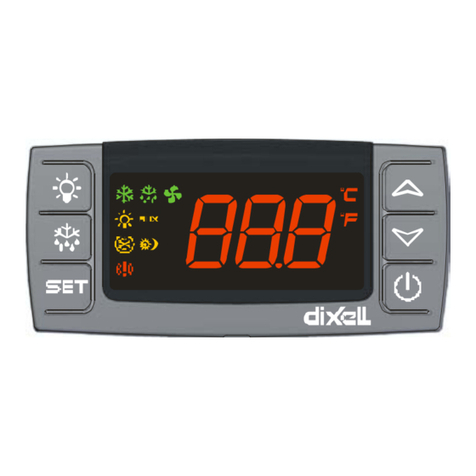
dixell
dixell XR10CX Installing and operating instructions

DIEL
DIEL MT200 LITE Installation and instruction manual
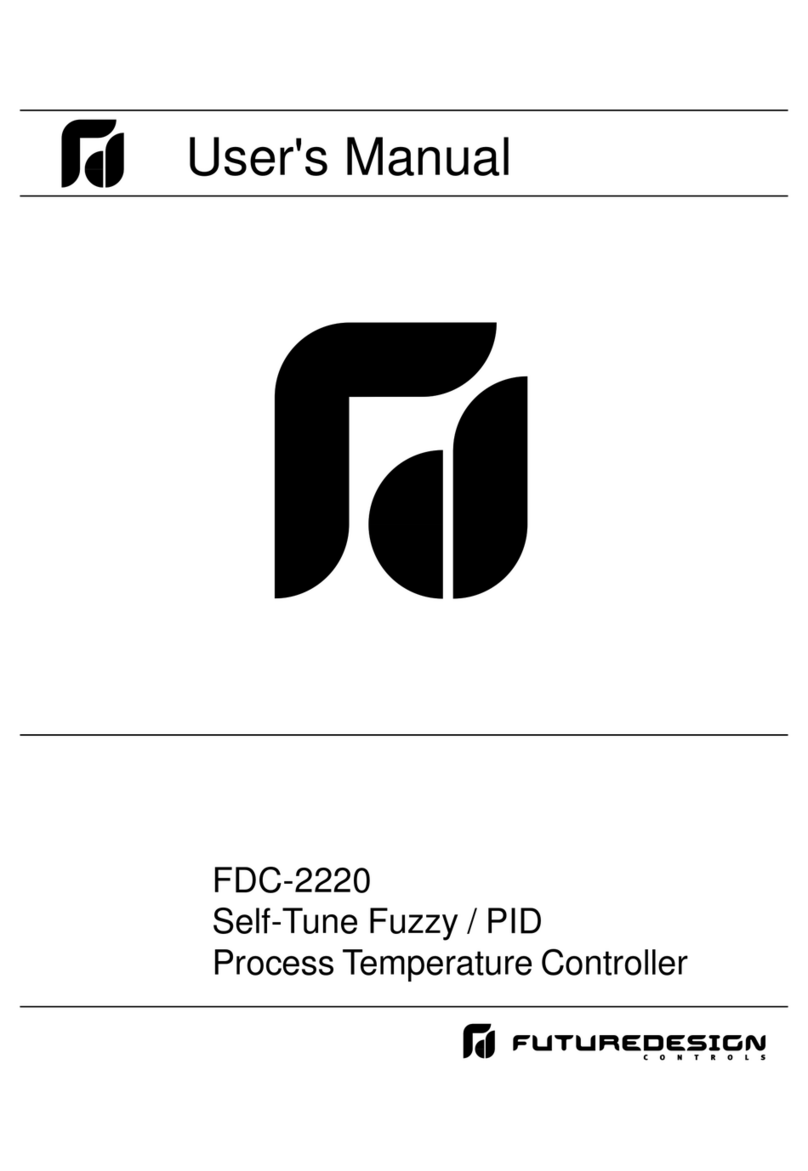
Future Design
Future Design FDC-2220 user manual
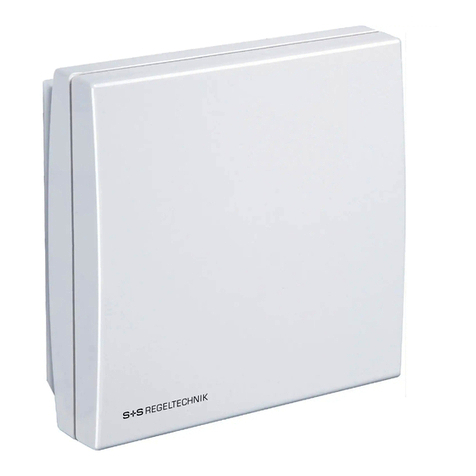
S+S Regeltechnik
S+S Regeltechnik AERASGARD RFTM-PS Series Operating Instructions, Mounting & Installation

Hanshin
Hanshin Smart Thermal Detector user manual
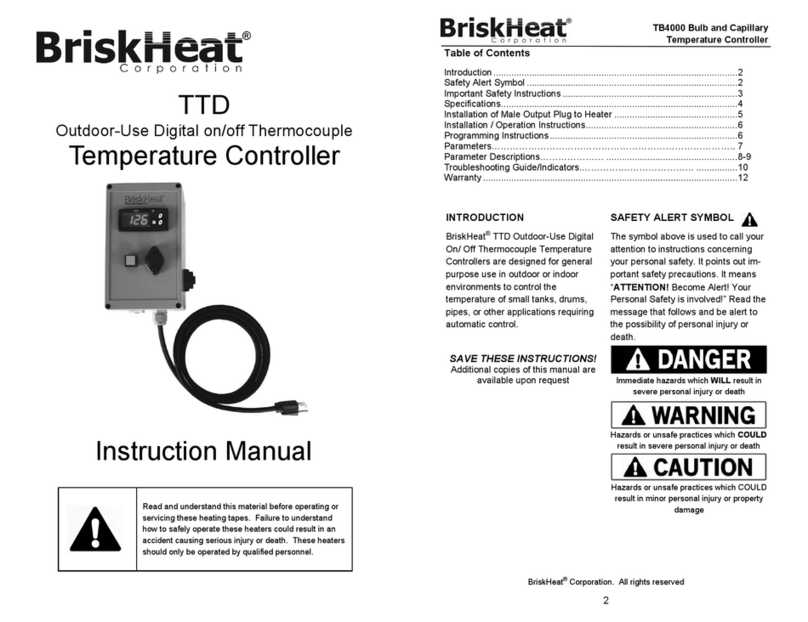
BriskHeat
BriskHeat TTD instruction manual

